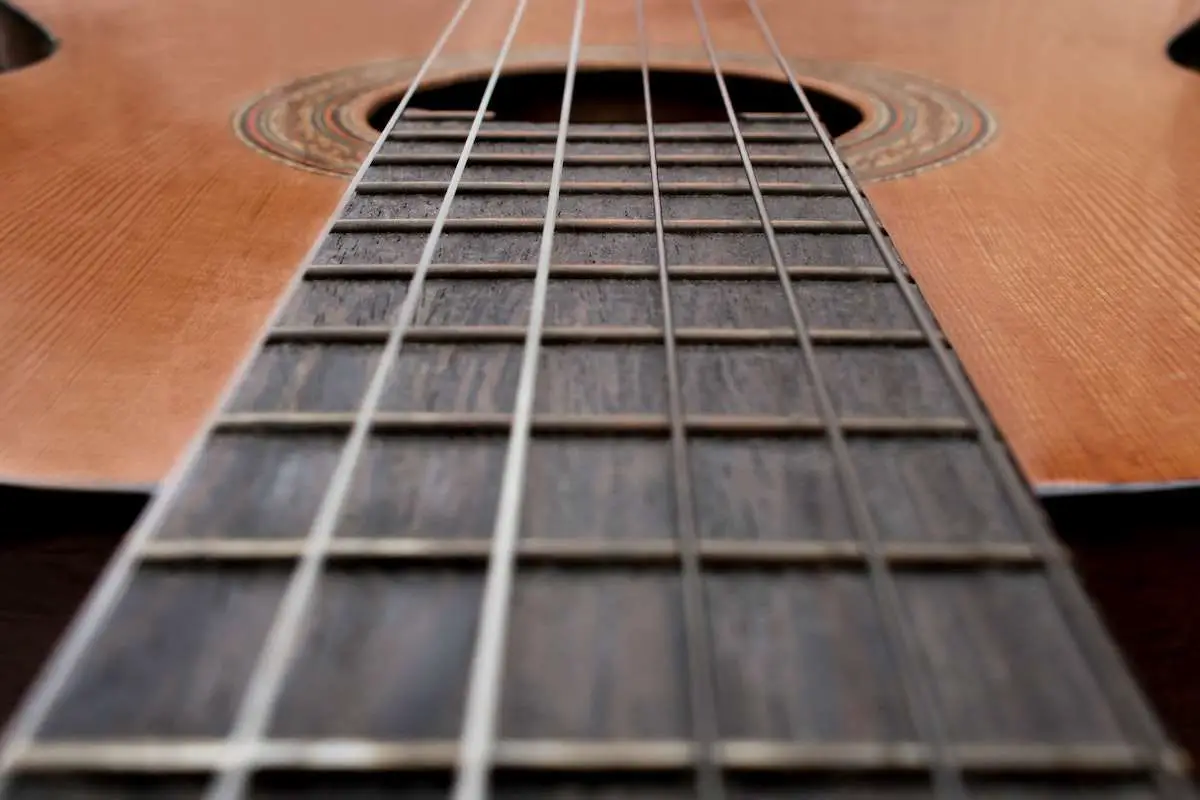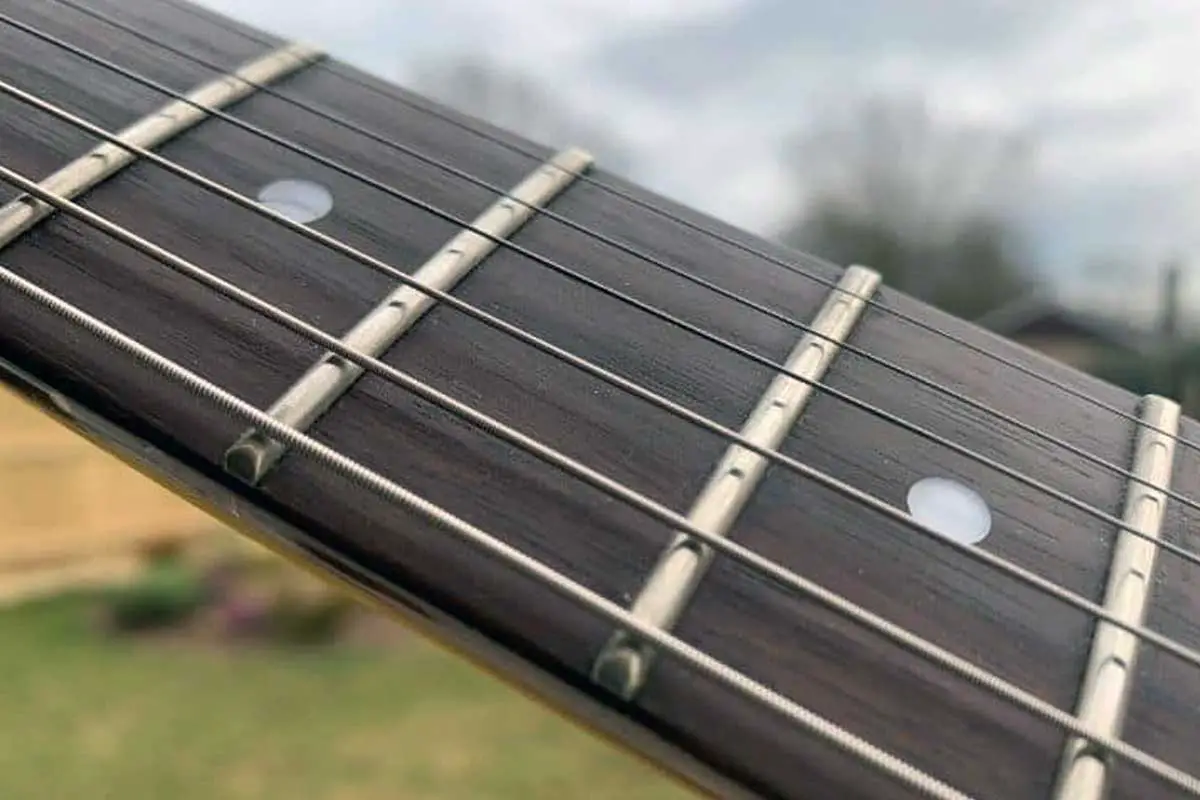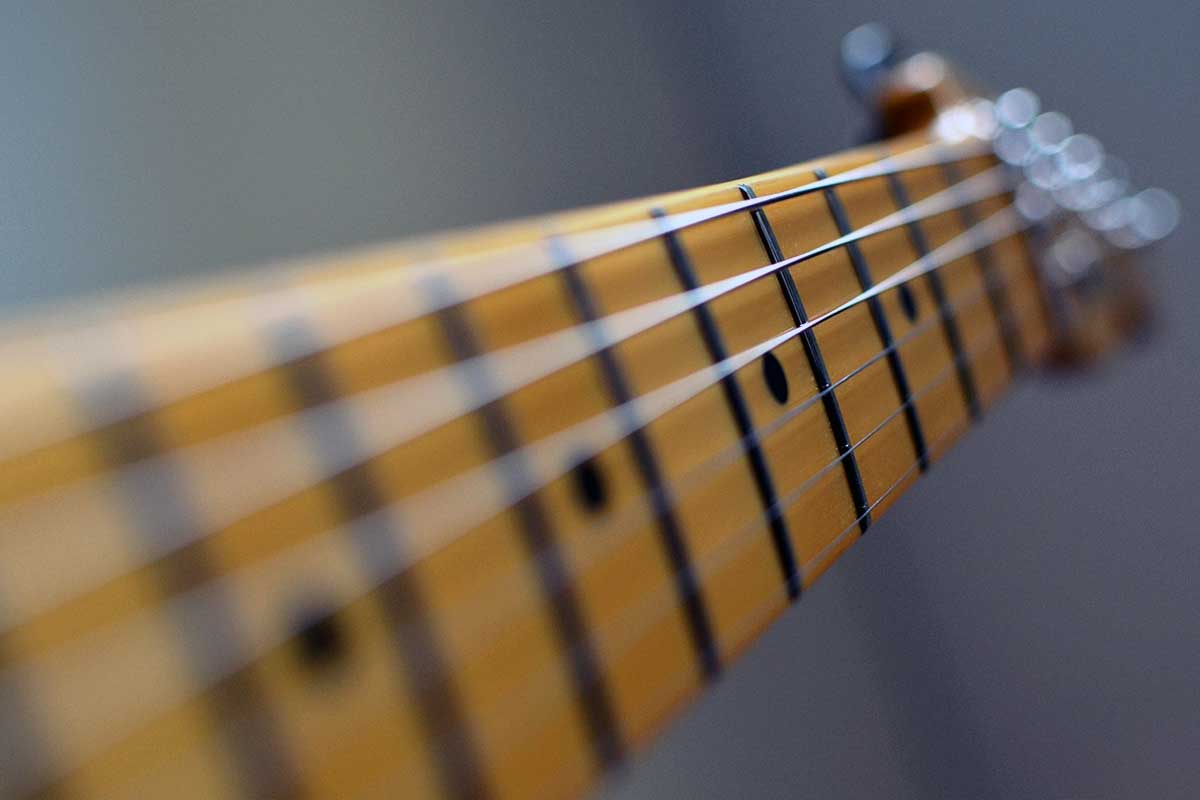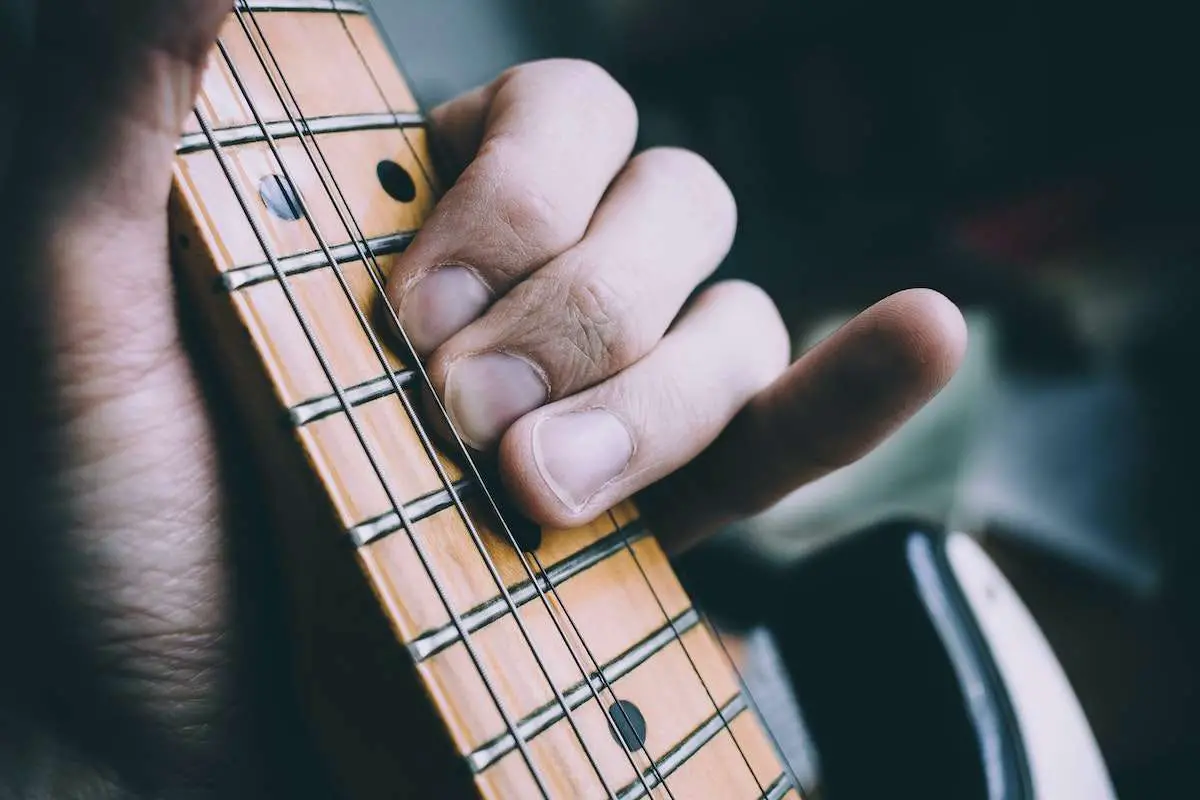Keeping your guitar in tip-top shape requires more than just tuning and polishing the body. Learning how to clean a guitar fretboard is an often overlooked aspect of guitar maintenance, which not only maintains its aesthetic appeal but also ensure optimal playability and extend its lifespan.
In this article we’ll cover how to clean finished & unfinished fretboards, how to condition your fingerboard, and polish up the frets. If you’re new to guitar maintenance stay tuned for the various tips & frequently asked questions.

The Importance of Maintaining a Clean Fretboard
A clean fretboard is essential for several reasons. Firstly, it improves playability by allowing your fingers to glide effortlessly across the surface. A grimy or dirty fretboard can cause friction and hinder your ability to move smoothly between chords and notes.
Secondly, a clean fretboard enhances the overall tone of your guitar. Dirt, sweat, and grime can build up over time, dampening the vibrations of the strings against the metal frets. This interference can result in muffled or dull sounds that detract from the clarity and sustain of your playing. Maintaining a clean fretboard contributes to the longevity of your instrument.
Finally, excessive dirt accumulation or improper care can cause the wood to dry out & crack, warp, or develop problems with the frets such as fret sprout.
Materials Needed for the Cleaning Process
Before diving into cleaning your guitar’s fretboard, it’s important to gather all necessary materials:
- A soft cloth: Opt for lint-free microfiber or cotton cloth that won’t scratch or leave fibers behind.
- Lemon oil, specialized fretboard cleaner, or mineral oil: These products effectively remove dirt and grime while nourishing the wood.
- A toothbrush (optional): Used for more stubborn grime in between the frets.
- Protective material: Masking tape or fretboard guard for polishing maple fretboards or sealed fingerboards
- Fine steel wool or specialized metal cleaner (for polishing frets): To remove oxidation from metal frets. Only use fine wool rated at 0000 or 00000.
Gathering these materials will ensure you have everything you need to clean your guitar’s fretboard effectively and safely without causing any damage or leaving residue behind.
Now that you understand the importance of maintaining a clean fretboard and have the necessary tools at hand, let’s dive into the step-by-step process of cleaning different types of fretboards.
Preparing for Cleaning
Loosening the guitar strings
Before diving into the cleaning process, it’s essential to loosen the guitar strings. By doing so, you’ll have better access to the fretboard surface and reduce the risk of accidentally snapping a string during cleaning.
Gently turn the pegs in a counterclockwise direction until you feel slight tension release from each string. If you want to keep your strings on, remember not to loosen them too much as this may cause them to completely unravel or pop out of their slots.
It’s a good idea to do this during a string change however, as you can simply remove the strings & have more access to the parts that need cleaning.
Removing Dirt and Grime
A Quick Wipedown with a Gentle Touch
Ah, the joys of playing guitar – strumming those chords, picking those riffs, and just losing yourself in the music. But after countless hours of jamming, your trusty fretboard can accumulate quite the collection of dirt and grime. Fear not!
The next step after loosening or removing the strings is to find yourself a soft & lint free cloth.
Be sure to select a cloth that won’t scratch or damage the wood. A clean microfiber cloth works wonders here.
Gently glide it along the length of your fretboard, paying close attention to the areas around the frets where dirt tends to gather. Apply some pressure and see what you can remove in a quick pass.
Alternatively you can use a soft-bristled toothbrush to scrub away near the fret crevices.
This simple act alone can remove most superficial debris that may have accumulated from your fingers or guitar picks.
Delving Deeper with Lemon Oil Magic
Sometimes surface cleaning isn’t quite enough to restore your fretboard’s former glory. For deep cleaning, you will want to use lemon oil, specialized fretboard cleaner, or plain ol’ mineral oil can work like magic.
These cleaners will not only cleanse but also nourishes the wood, rejuvenating its natural beauty.
To begin, simply apply a small amount of cleaner of your choice onto the cloth & gently rub this cloth along the length of your fretboard. You can also bring back the toothbrush for this step if you’ve got some heavy grime.
Any of these options will effectively dissolve grime and bring out the rich tones of your wood grain. Take care not to oversaturate the fretboard with excess oil though; a little goes a long way!
After applying, allow the solutions to sit for several minutes so that they can penetrate into any clogged pores and moisturize deeply. Once you’ve let it work its magic, wipe away any excess oil with a clean cloth.
Voilà! Your fretboard will thank you for the pampering session, looking vibrant and ready to sing harmoniously with your melodies once more.
Cleaning Different Types of Fretboards

How To Clean Rosewood Fretboard (Unfinished)
Oh, the allure of a rich, dark rosewood fretboard! But over time, dirt and grime can tarnish its beauty. Here’s the secret to restore its luster without harming an unfinished fretboard.
To tackle stubborn grime, start by gently scrubbing the fretboard with a soft bristle brush or fine steel wool (0000 or finer) if necessary. Remember, gentle is the keyword here – you don’t want to scratch or damage this delicate wood.
The great thing about using steel wool here, is that you can use it to clean the fretboard & polish the frets at the same time! This only works on un-finished fingerboards though, you don’t want to use steel wool on a sealed fingerboard or it can damage the guitar’s finish.
Once you’ve removed most of the dirt, it’s time to give your rosewood fretboard some much-needed moisturizing. Using a soft cloth, apply oil ( lemon or mineral), or a specialized conditioner onto the fretboard’s surface.
Be generous but not excessive; you want to moisturize without saturating the wood. Let it sit for a few minutes to allow absorption before wiping off any excess oil.
That’s it! Your rosewood fretboard will regain its striking appearance and feel smooth beneath your fingertips.

How To Clean Maple Fretboard (Finished)
Maple fretboards are known for their bright look that complements any guitar body color. However, cleaning these lighter woods which are typically sealed or “finished”, requires a different approach.
When cleaning your maple fretboard, it’s crucial to avoid excessive moisture as water can seep into porous areas and cause damage. For light stains on your maple fretboard, mix a mild soap and water solution in a small bowl.
Dip a soft cloth into this soapy potion and gently wipe away those pesky blemishes with patience and care. Remember not to soak the cloth too much; you don’t want drips of soapy water causing problems later on!
Once satisfied with your cleaning efforts, use another damp cloth to remove any soap residue, and then dry the fretboard thoroughly. Sealed fretboards may not require as much moisturizing as other types, but if you feel the need, a dab of lemon oil can be applied sparingly for a touch of nourishment.
Ebony and Other Exotic Wood Fretboards: Unleashing Your Inner Preservationist
Ebony fretboards & other exotic woods deserve extra TLC to maintain their natural beauty and unique characteristics. When it comes to cleaning these fretboards, remember that less is more.
The goal here is to preserve the natural oils within the wood rather than strip them away. For this reason, you don’t want to ever use solvents such as alcohol or hash chemicals.
Similar to the sealed fretboard, we want to take great care to use a soft & slightly damp cloth or even a soft bristled toothbrush to gently wipe away dirt and grime from the surface of an ebony fretboard. Avoid applying excessive pressure or using abrasive materials that might scratch or damage the exotic wood.
Once clean, it’s time to treat this luxurious wood with specialized cleaners which we cover in the next section.
Nourishing & Conditioning the Fretboard
Applying lemon oil, mineral oil, or fretboard conditioner after cleaning
After successfully removing dirt and grime from your guitar’s fretboard, the next step is to nourish and condition it to maintain its vitality and longevity. One effective way to achieve this is by applying an oil or a specialized fretboard conditioner.
These products work wonders in replenishing natural oils, preventing the wood from drying out, and enhancing its overall appearance. Mind you they should not be used more than 2-3 times a year.
Lemon oil is commonly touted as the best, however there are also specially designed products from big brands for this purpose.
One thing to note here though, is that the majority of cleaning & condition products, as well as lemon oil, are made with mineral oil as a core ingredient. If you want to save a couple bucks, you can simply grab a small bottle of mineral oil from a local pharmacy.
Also you shouldn’t use olive oil (or any vegetable oil) as it will break down & go rancid over time.
Letting the oil soak in before wiping off excess
Once you have selected the appropriate conditioner for your fretboard, it’s time to apply it generously but mindfully. Before you start, remember to protect your guitar’s body and hardware using a cloth or plastic wrap to avoid any accidental spills or damage. Using a soft cloth or applicator pad, gently rub the lemon oil or conditioner onto the entire surface of the fretboard.
Ensure that you cover all areas evenly while avoiding excessive saturation. Once applied, give the oil a couple of minutes to penetrate deep into the wood grain, allowing it to moisturize the fretboard.
It’s crucial not to rush this step; let nature take its course! Letting the oil soak in for at least 5 minutes will allow maximum absorption before proceeding further.
Patience is key here as giving ample time for absorption will yield better results in terms of conditioning and preserving your instrument’s health. After allowing enough time for absorption, take a clean cloth and gently wipe off any excess oil from the fretboard.
This step is essential to prevent a sticky residue and ensure a smooth playing experience. Take your time and be thorough, gently wiping in the direction of the wood grain until no excess oil remains on the surface.
Remember, nourishing and conditioning your guitar’s fretboard should be done regularly to keep it in optimal condition. By following these steps, you will not only maintain its appearance but also promote its longevity, ensuring that your guitar remains a joy to play for years to come.
How To Polish Guitar Frets & Final Touches
Buffing Frets for Shine and Smoothness
Once you’ve successfully cleaned your fretboard, it’s time to give your frets the lustrous shine they deserve. Buffing is an important step that not only enhances their appearance but also improves playability.
If you have a bare fretboard like an open pore rosewood, you could have simply polished the frets while cleaning using steel wool.
If you have a finished fretboard however, you will need to tape up your fretboard or use a fingerboard guard for this next step.
All you have to do is take some 0000 grit steel wool & carefully rub the frets up & down to polish them up & make the smooth.
Alternatively you can use this method using emery sanding sponges, nail buffs, or micro-mesh as such:
Remember to maintain a smooth, consistent motion while buffing to achieve an even shine across all the frets. Once you’ve covered the entire fretboard, take a step back and admire the gleaming result of your hard work!
All that’s left to do is re-tune your guitar or install a fresh set of new strings & you are good to go.
Related: Why do my guitar strings rattle
Other Guitar Maintenance Articles
| Component | Related Articles |
|---|---|
| Body Finish | How to clean your guitar’s body |
| Bridge & Tailpiece | How to clean a guitar bridge |
| Fingerboard | How to clean your fretboard |
| Frets | How to clean your guitar frets |
| Pickups | How to clean pickups |
| Pots | How to clean guitar potentiometers |
| Strings | How to clean guitar strings |
| Tuners | How to clean guitar tuners |

Frequently Asked Questions
What household items can you use to clean a fretboard?
We recommend using some very mild soap, but even just plain water & a bit of effort will go a long way. Mineral oil is also good for cleaning the fretboard & moisturizing the wood at the same time. If you want to be proper, simply go with a dedicated guitar polish or conditioner for this purpose.
Is it OK to clean a fretboard with water?
Yes, clean water works well with sealed or finished fretboards. If you have an unfinished fingerboard, just be careful not to use too much water. In any case, you really just need a slightly damp cloth to get the job done.
Can I use olive oil on my fretboard?
No we don’t recommend using any sort of vegetable oil as these oils will break down over time & become gunky, sticky, or smell bad as they go rancid.
Can you clean a fretboard with the strings still on?
Yes, simply loosen all the strings with a couple of turns in order to maneuver around them while cleaning. Once finished, be sure to tune your strings back up & give them a quick wipe down.
Can I use rubbing alcohol to clean fretboard?
Yes but be aware that any solvent like this will dry out the oils of your fretboard. Be sure to apply an oil after using this. It’s much better to simply use clean water.
Conclusion
Cleaning and maintaining your electric guitar fretboard is an essential aspect of preserving its playability and overall condition. By following these steps diligently, you can keep your instrument sounding its best for years to come. Cleaning not only removes dirt and grime but also allows you to connect with your guitar more intimately as you become attuned to every detail of its construction.
So next time you embark on this cleaning journey, embrace it as an opportunity to bond with your guitar. The satisfaction of seeing a clean, well-cared-for fretboard will inspire you to play with renewed vigor and creativity.
Remember, the care and attention you invest in your instrument translate into enhanced musical experiences, and ultimately, a clearer path to guitar greatness. Happy strumming!
